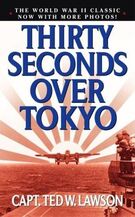Tokyo Raid/"Doolittle Raid" (April 18, 1942)
"The Doolittle Raid, also known as the Tokyo Raid (Saturday 18 April 1942), was an air raid by the United States on the Japanese capital Tokyo and other places on Honshu during World War II. It was the first air operation to strike the Japanese archipelago. It demonstrated that the Japanese mainland was vulnerable to American air attack, served as retaliation for the attack on Pearl Harbor, and provided an important boost to American morale. The raid was planned, led by, and named after Lieutenant Colonel James Doolittle of the United States Army Air Forces.
Sixteen B-25B Mitchell medium bombers were launched without fighter escort from the U.S. Navy's aircraft carrier USS Hornet deep in the Western Pacific Ocean, each with a crew of five men. The plan called for them to bomb military targets in Japan, and to continue westward to land in China. Landing a medium bomber on the Hornet was impossible. The bombing raid killed about 50 people, including civilians, and injured 400. Fifteen aircraft reached China, but all crashed, while the 16th landed at Vladivostok in the Soviet Union. Of the 80 crew members, 77 initially survived the mission. Eight airmen were captured by the Japanese Army in China; three were later executed. The B-25 that landed in the Soviet Union was confiscated and its crew interned for more than a year before being allowed to "escape" via Soviet-occupied Iran with the help of the NKVD. Fourteen complete crews of five, except for one crewman who was killed in action, returned either to the United States, or to American forces.
After the raid, the Japanese Army conducted a massive sweep through the eastern coastal provinces of China, in an operation now known as the Zhejiang-Jiangxi campaign, searching for the surviving American airmen and inflicting retribution on the Chinese who aided them, in an effort to prevent this part of China from being used again for an attack on Japan.
The raid caused negligible material damage to Japan, but it had major psychological effects. In the United States, it raised morale. In Japan, it raised doubt about the ability of military leaders to defend the home islands, but the bombing and strafing of civilians also steeled the resolve to gain retribution and was exploited for propaganda purposes. It also contributed to Admiral Isoroku Yamamoto's decision to attack Midway Island in the Central Pacific—an attack that turned into a decisive strategic defeat of the Imperial Japanese Navy (IJN) by the U.S. Navy in the Battle of Midway. The consequences were most severely felt in China, where Japanese reprisals caused the deaths of 250,000 civilians and 70,000 soldiers.[6]
Doolittle, who initially believed that the loss of all his aircraft would lead to his court-martial, received the Medal of Honor and was promoted two ranks to brigadier general."
Source: Wikipedia
Sixteen B-25B Mitchell medium bombers were launched without fighter escort from the U.S. Navy's aircraft carrier USS Hornet deep in the Western Pacific Ocean, each with a crew of five men. The plan called for them to bomb military targets in Japan, and to continue westward to land in China. Landing a medium bomber on the Hornet was impossible. The bombing raid killed about 50 people, including civilians, and injured 400. Fifteen aircraft reached China, but all crashed, while the 16th landed at Vladivostok in the Soviet Union. Of the 80 crew members, 77 initially survived the mission. Eight airmen were captured by the Japanese Army in China; three were later executed. The B-25 that landed in the Soviet Union was confiscated and its crew interned for more than a year before being allowed to "escape" via Soviet-occupied Iran with the help of the NKVD. Fourteen complete crews of five, except for one crewman who was killed in action, returned either to the United States, or to American forces.
After the raid, the Japanese Army conducted a massive sweep through the eastern coastal provinces of China, in an operation now known as the Zhejiang-Jiangxi campaign, searching for the surviving American airmen and inflicting retribution on the Chinese who aided them, in an effort to prevent this part of China from being used again for an attack on Japan.
The raid caused negligible material damage to Japan, but it had major psychological effects. In the United States, it raised morale. In Japan, it raised doubt about the ability of military leaders to defend the home islands, but the bombing and strafing of civilians also steeled the resolve to gain retribution and was exploited for propaganda purposes. It also contributed to Admiral Isoroku Yamamoto's decision to attack Midway Island in the Central Pacific—an attack that turned into a decisive strategic defeat of the Imperial Japanese Navy (IJN) by the U.S. Navy in the Battle of Midway. The consequences were most severely felt in China, where Japanese reprisals caused the deaths of 250,000 civilians and 70,000 soldiers.[6]
Doolittle, who initially believed that the loss of all his aircraft would lead to his court-martial, received the Medal of Honor and was promoted two ranks to brigadier general."
Source: Wikipedia
|
|
|
Books
